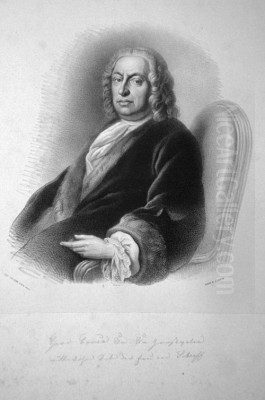
Sebastiano Conca stands as a significant figure in the transition from the High Baroque to the Rococo style in Italian painting. Born in Gaeta on January 8, 1680, and living a long and prolific life until his death in Naples on September 1, 1764, Conca navigated the complex artistic currents of the late 17th and 18th centuries. His career, primarily centered in Naples and Rome, was marked by prestigious commissions, influential teaching, and a distinctive style that blended Neapolitan dynamism with Roman classicism.
Early Life and Neapolitan Training
Conca's artistic journey began in the vibrant artistic milieu of Naples, a major center of the Baroque style. He entered the studio of Francesco Solimena, who was then the leading painter in the city. Solimena's powerful, dramatic, and richly colored compositions, themselves influenced by artists like Luca Giordano and Mattia Preti, provided Conca with a strong foundation in the late Baroque idiom. Under Solimena's tutelage, Conca honed his skills in drawing and painting, absorbing the energy and theatricality characteristic of the Neapolitan school. His early works likely reflected this formative influence, emphasizing dynamic movement and strong emotional expression.
The Move to Rome and Early Success
In 1706, seeking broader opportunities and exposure to the classical traditions prevalent in the papal city, Sebastiano Conca moved to Rome. He was accompanied by his brother, Giovanni Conca, who served as his assistant. This move proved pivotal for his career. Rome offered a different artistic environment, one where the legacy of High Baroque classicism, particularly the style of Carlo Maratta, still held considerable sway, even as newer, lighter Rococo trends began to emerge.
Conca quickly attracted important patronage in Rome. Cardinal Pietro Ottoboni, a prominent patron of the arts, took notice of his talent and provided crucial support. Through Ottoboni's connections, Conca was introduced to Pope Clement XI. This papal connection led to significant commissions and recognition. His talent was initially recognized through his skillful drawings, but he soon transitioned fully to oil painting, developing a style that would bring him widespread acclaim.
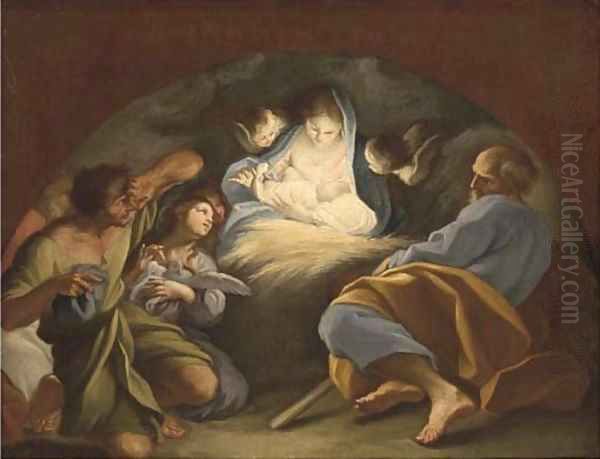
A major breakthrough came with his commission to paint a fresco of the Prophet Jeremiah in the Basilica di San Giovanni in Laterano (St. John Lateran). This work, completed around 1718, deeply impressed Pope Clement XI with its skillful execution and emotional depth. As a reward for this achievement and his growing reputation, the Pope conferred upon Conca the title of Knight (Cavaliere) and awarded him a cross, signifying his elevated status within the Roman artistic and social hierarchy.
Artistic Style and Development
Sebastiano Conca's mature style represents a fascinating synthesis of his Neapolitan training and the influences he absorbed in Rome. While retaining the dynamism and rich palette derived from Solimena and the broader Neapolitan Baroque tradition influenced by figures like Luca Giordano, Conca increasingly tempered this with the more restrained, classical elegance championed by Carlo Maratta and his followers, such as Giuseppe Chiari and Benedetto Luti.
His paintings are characterized by a fluid, confident brushwork and complex, often theatrical compositions. He excelled in creating large-scale narrative scenes, whether religious, mythological, or historical, imbuing them with emotional intensity. Conca possessed a remarkable ability to handle light and shadow (chiaroscuro), using it effectively to model forms, create depth, and enhance the dramatic impact of his scenes. His color palette was typically vibrant and appealing, contributing to the overall visual richness of his work.
Over his long career, his style evolved, gradually incorporating lighter tones and more graceful rhythms that aligned with the emerging Rococo aesthetic, particularly evident in his easel paintings and smaller devotional works. However, he never fully abandoned the underlying structure and grandeur of his Baroque formation. This blend allowed him to appeal to a wide range of patrons, from the Church demanding grand religious statements to private collectors seeking elegant mythological or allegorical pieces. His style was considered mature, accomplished, and highly adaptable to different formats and subjects.
Major Works and Commissions
Conca was exceptionally prolific, undertaking numerous commissions for altarpieces, large-scale fresco decorations, and easel paintings throughout his career. His work adorned churches, palaces, and private collections across Italy and beyond.
The aforementioned Jeremiah fresco in St. John Lateran remains one of his most celebrated early Roman works. Another significant commission was the fresco depicting the Coronation of Saint Cecilia in the vault of the Church of Santa Cecilia in Trastevere, Rome, completed around 1725. This work further solidified his reputation as a master of large-scale decorative painting and earned him continued papal favor.
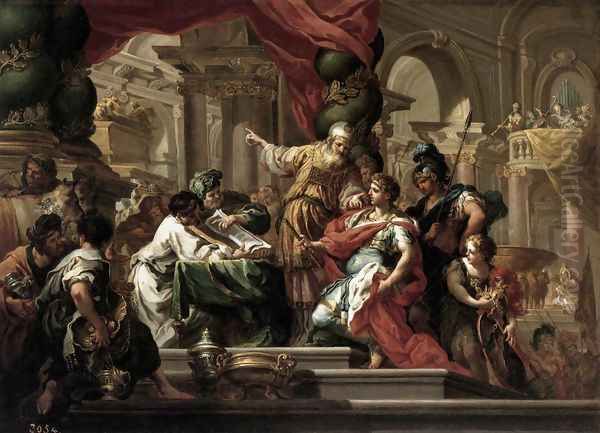
His masterpiece is often considered to be the vast fresco depicting the Pool of Bethesda (Probatica Piscina), painted between 1738 and 1740 for the Ospedale di Santa Maria della Scala in Siena. This complex and dynamic composition showcases his mature style, his command of color, and his ability to manage large numbers of figures within a coherent narrative space.
Other notable works include the Adoration of the Shepherds, a theme he revisited, showcasing his skill in devotional painting. He also painted numerous mythological and allegorical subjects, such as Alexander the Great in the Temple of Jerusalem, which demonstrates his ability to handle historical narratives with dramatic flair, and Venus at the Forge of Vulcan, highlighting his use of light and dynamic composition. Allegorical works like the Allegory of Painting and Allegory of Music were also part of his diverse output, catering to the tastes of learned patrons.
The Accademia di San Luca and Influence
Conca's success was not limited to commissions; he also played a significant role in Rome's official artistic institutions. In 1729, he was elected a member of the prestigious Accademia di San Luca, the city's academy of artists. His standing among his peers was such that he served multiple terms as the academy's director, or Principe, notably between 1739 and 1741. This position placed him at the center of artistic life and pedagogy in Rome.
He maintained a large and busy workshop, attracting numerous students and assistants who helped him fulfill his many commissions. Among his notable pupils were Pompeo Batoni, who would become one of the most famous portraitists and history painters in 18th-century Rome; Andrea Casali; the Sicilian painter Olivio Sozzi; and Corrado Giaquinto, who, although developing his own distinct Rococo style, spent time in Conca's circle. Others associated with his studio or influence include Pluto Pappini. Through his teaching and workshop activities, Conca exerted considerable influence on the next generation of painters in Rome.
Patronage and International Reputation
Beyond the crucial early support from Cardinal Ottoboni and Pope Clement XI, Conca enjoyed patronage from a wide array of clients. His reputation extended far beyond Rome and Naples. He received commissions from various Italian courts and noble families. His fame also reached other European countries; monarchs and aristocrats in Spain, Portugal, Poland, and Germany sought out his works.
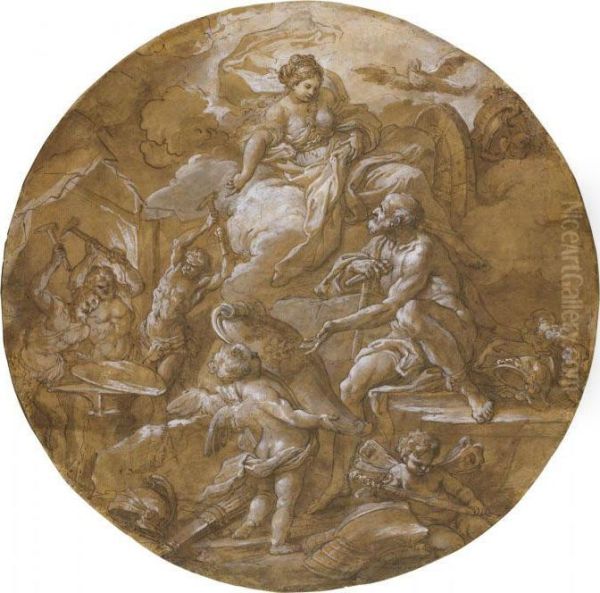
His paintings were particularly popular among foreign visitors undertaking the Grand Tour, especially British collectors. While large-scale frescoes and altarpieces remained in Italy, his smaller easel paintings – devotional images, mythological scenes, and allegories – were highly sought after as sophisticated souvenirs and additions to private collections abroad. This international demand contributed significantly to his wealth and fame, making him one of the most commercially successful artists of his time.
Contemporaries and Artistic Context
Sebastiano Conca operated within a vibrant and competitive artistic landscape. In Naples, his primary influence was his teacher, Francesco Solimena, and he worked in the shadow of the legacy of Luca Giordano. In Rome, he arrived when the dominant figure was Carlo Maratta, whose classicizing Baroque style set the tone. Conca skillfully navigated this environment, adapting Maratta's influence without entirely abandoning his Neapolitan roots.
He worked alongside and competed with other prominent painters active in Rome during the first half of the 18th century. These included figures like Benedetto Luti, Francesco Trevisani, Giuseppe Chiari, and Pietro Bianchi, each contributing to the diverse artistic production of the era. His relationship with the architect Luigi Vanvitelli, a major figure in Neapolitan and Roman architecture, also proved beneficial, potentially leading to collaborative opportunities or commissions within architectural projects. His student, Pompeo Batoni, eventually emerged as a leading figure in his own right, representing a later phase of Roman painting. The presence of these and other artists created a dynamic environment of stylistic exchange, influence, and rivalry.
Later Years and Legacy
Around 1752, after nearly five decades in Rome, Sebastiano Conca returned to Naples. The reasons for his return may have been varied, perhaps related to opportunities at the Bourbon court of Naples or simply a desire to return to his roots in his later years. He remained active as a painter in Naples, continuing to receive commissions.
He died in Naples on September 1, 1764, at the advanced age of 84, concluding a remarkably long, productive, and successful career. He left behind a vast body of work and a significant legacy as one of the leading Italian painters of the 18th century. His ability to synthesize different stylistic trends and cater to diverse patrons ensured his prominence during his lifetime.
Works in Collections Today
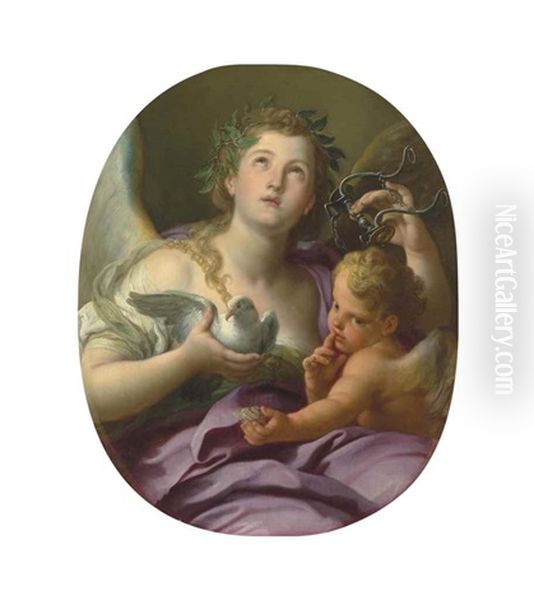
Sebastiano Conca's artistic legacy endures today, with his works held in numerous major museums and collections worldwide. Important examples can be found in the Vatican Museums (including works like the Deposition from the Cross), the Prado Museum in Madrid, the J. Paul Getty Museum in Los Angeles, the Museum of Fine Arts in Boston, the Indianapolis Museum of Art, and the National Gallery of Capodimonte in Naples, among many others. Churches in Rome, Naples, Gaeta, Siena, and other locations still preserve his altarpieces and frescoes in situ.
His paintings also continue to appear on the international art market, featuring in auctions at major houses like Christie's and Sotheby's. The prices and attention his works command attest to his continued recognition and the appreciation for his skillful execution and historical importance. The presence of his works in both public institutions and private collections highlights his lasting appeal.
Critical Reception and Assessment
Academic and critical assessment of Sebastiano Conca has generally acknowledged his importance as a major figure in 18th-century Italian painting. He is praised for his technical proficiency, his mastery of large-scale composition, his vibrant use of color, and his prolific output. His role as a key transitional figure between the late Baroque and the emerging Rococo style is widely recognized. His success in securing prestigious commissions and his influential position as head of a major workshop and Principe of the Accademia di San Luca further underscore his significance.
However, his reputation has not been without nuance or criticism. Some scholars and critics have argued that his style, while accomplished, could sometimes be formulaic or overly reliant on the models of his predecessors, particularly Solimena and Maratta, suggesting a lack of profound originality compared to some other masters. Anecdotal accounts from contemporaries sometimes portrayed him as proud or overly concerned with worldly success, although the impact of this on his art is debatable. Furthermore, as with many prolific artists with large workshops, issues of attribution occasionally arise, with some works historically misattributed or requiring careful connoisseurship to distinguish the master's hand from that of his assistants.
Despite these points of discussion, Sebastiano Conca remains a highly regarded artist. His vast oeuvre provides a rich testament to the artistic vitality of 18th-century Italy, and his career exemplifies the successful navigation of the complex demands of patronage, academic institutions, and evolving artistic tastes during a period of significant stylistic change. He stands as a master craftsman and a defining painter of his era.